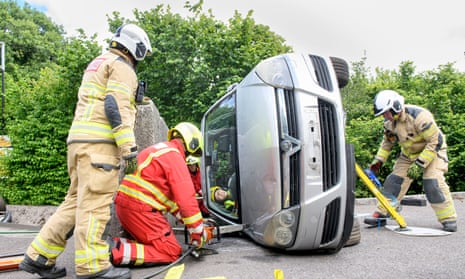There are plans for a major overhaul of how people are rescued from car wrecks amid growing evidence that current methods where people wait to be cut free may be harmful.
Last year there were 127,967 casualties and 1,560 deaths in England caused by motor vehicle collisions. During the same period, more than 7,000 patients needed to helped out of the vehicle through a process known as extrication, where rescue crews use “Jaws of Life” and other tools to pry apart the wreckage, and then carefully lift people out.
Although in some cases patients’ limbs are trapped or they are unable to move because their injuries are so severe, in most cases they could climb free with minimal assistance, eg after unjamming a stuck door, but stay in their vehicles because of pain and/or concern that moving them may exacerbate their injuries – particularly spinal injuries.
“Since at least the 1980s, firefighters have been trained with movement minimisation as the absolute paradigm,” said Dr Tim Nutbeam, an NHS emergency medicine consultant, and medical lead for the Devon air ambulance. “They’ve been told that one millimetre of movement could turn someone into a wheelchair user, so will often disassemble the car around the patient, to avoid movement of the neck.”
Yet, doing so takes time – 30 minutes on average – and if that person has another serious injury, such as a head, chest, or abdominal injury, every minute counts.
Nutbeam began researching the issue after noticing a disconnect between concerns about spinal movement, and the injuries he was seeing in his patients – including experiencing people die in their vehicles, or shortly after they were removed.
He discovered that trapped patients were almost twice as likely to die as those who were rapidly freed from the wreckage. Further, that the prevalence of spinal injuries among such patients was, in fact, extremely low – just 0.7% – and in around half of these cases, they had other serious injuries needing urgent medical attention.
“Our absolute focus on movement minimisation works for maybe 0.3% of patients, but it extends the entrapment time for 99.7% of them,” Nutbeam said. “Potentially hundreds of people in this country have died as a result of extended entrapment times, and if you multiply that worldwide, it’s many, many people.”
Nutbeam and his colleagues fixed movement sensors to healthy volunteers and measured their neck and spinal movements as they were extricated from various vehicle crash scenarios, using different techniques.
Although these experiments are ongoing, early results have suggested that the spinal movements associated with assisted extrication are much larger than when volunteers are allowed to climb out of the wreckage themselves, and that rapid assisted extrication techniques produced similar movements to slower ones aimed at movement minimisation.
In other words, the more movements a patient can do for themselves, the less spinal movement is likely to be associated with it. Although patients with genuine spinal injuries will still require a gentle approach, “probably self-extrication where possible is going to be better, regardless of the type of injury”, Nutbeam said.
Currently, only around 3% of UK fire and rescue services use self-extrication on a regular basis, but this is likely to change as a result of these studies.
In a consensus paper, UK stakeholders including the National Fire Chiefs Council (NFCC) and the College of Paramedics reviewed the existing evidence, and have agreed a set of principles for future guidance.
These include a recommendation that self- or minimally assisted extrication should be the standard “first line” for trapped patients who are conscious and likely to be able to stand with assistance, and that minimising entrapment time should be the goal for all patients.
“This research will reduce both deaths and disabilities and help us achieve our vision of zero deaths and serious injuries on UK roads,” said Sally Lines, CEO of the Road Safety Trust, which funded the study. “We look forward to the practical application of this research being used by emergency services.”
Already, the United Kingdom Rescue Organisation (UKRO) has adopted the new principles for their Extrication Challenge in September 2022, in which UK fire and rescue crews compete to free people from various challenging scenarios.
They should also enable fire crews to develop new extrication techniques, such as dragging vehicles clear of obstacles, with casualties still inside them, said James Coomber, a road traffic collision instructor for UKRO. “Without 360 degree access, ambulance staff often struggle to fully expose and assess the patients, resulting in injuries being missed or significant treatment delays. By adopting these new principles and reconsidering techniques such as relocating the vehicle, we can [potentially] reduce that extrication time, increasing their chances of survival.”
The NFCC is also planning further tests, in light of Nutbeam’s research. “The main aim of the UK fire and rescue service is to save lives and prevent injury, therefore we will always look to update and change guidance,” said Chris Lowther, chair of NFCC’s operations committee. “As a result of this research, further work will be undertaken as to how extrication could be [performed]. Once we have this, we will look as to how any changes could be introduced into our national operational guidance.”
